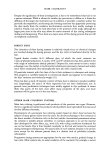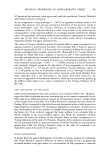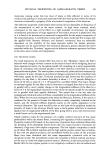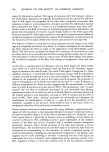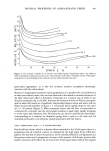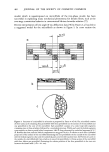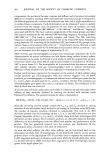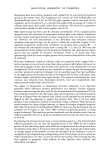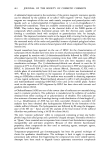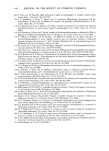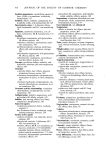PHYSICAL PROPERTIES OF ALPHA-KERATIN FIBERS 397 2./. 2.2 z •l.8- luJ 1.6- I- 1./.- I.Ul 1.0- u") .8 o •73.8 ._•_85 92.5 100 li) J0 3'0 ZO 5'0 6'0 STRAIN 6 Figure 3. The dynamic modulus E • of Lincoln wool fibers against longitudinal strain e for different relative humidities as indicated on each curve. The drop of E • as the fiber is extended into the Yield region corresponds to the unfolding of the ce-helical structure within the fiber (see text). particularly appropriate, as is also the moisture sensitive amorphous thixotropic structure with the matrix phase. Because in longitudinal extension matrix properties act in parallel with microfibrils but in water are relatively weak, they are best observed in the lateral or torsional behavior of the fiber where their effect is dominant. Extension at a constant rate of strain in the direction perpendicular to the fiber direction for rhinoceros horn or African porcupine quill in water (65) results in a hyperbolic relationship between stress and strain with an initial incremental modulus of about 3 x 108 pascals which rapidly drops to the order of 2 x 107 pascals (Figure 2). When extension ceases and the fiber is reextended or contracted at a constant rate the incremental modulus is again high, rapidly dropping to a low value with distortion (65). This behavior can best be described as thixotropic, corresponding to a material on distortion going from a gel to a sol state and (as indicated previously) is the behavior already associated with the matrix. X-RAY DIFFRACTION AND tr ,,• /5 TRANSFORMATION Bendit (66) has shown that for oz-keratin fibers extended in the Yield region there is a progressive loss of g-helical content as indicated by the high angle X-ray diffraction pattern. He was able to detect the presence of the extended/3-keratin configuration at a few percent strain and a progressive increase of the amount of/3-keratin present with further extension of the fiber. At the end of the Yield region about 305o of the original
398 JOURNAL OF THE SOCIETY OF COSMETIC CHEMISTS •-keratin as judged by X-ray diffraction measurement had been unfolded. The process of unfolding the crystalline u-helical structure by extension and forming extended /3-keratin had been shown by Astbury (67) to be quite recoverable. When the fiber is returned on release to its original length, provided the temperature at which the extension occurred was not higher than about 50øC for a fiber in water, the/3-keratin disappeared and the •-keratin structure returned. The evidence appears clear, that in the Yield region the mechanical transformation of Burte-Halsey units from state A to state B, and units of crystalline u-helical material being unfolded forming extended /3-keratin are the same event. INFRA-RED ANALYSIS AND ELECTRICAL CONDUCTIVITY Infra-red absorption measurements on the Amide-N-H showed that if •x-keratin fibers were immersed in heavy water, exchange of -NH to --ND occurred primarily in the non-helical amide groups. However, when cr-keratin fibers in D20 are extended into the Yield region (and further) the deuteration occurs of the helical amide groups opened up by the extension (68). The unfolding of the •x-helices occurs with an apparent absoprtion of water by the opened up microfibrillar structure. Microscopic measurements by Haly (69) have shown that extension into the Yield region for a fiber in water is accompanied by an increase in moisture content for the fiber. Measurements of changes of electrical conductivity with extension into the Yield region also clearly indicate that the process of extension of a fiber is accompanied by moisture uptake into the micro fibrils. If in a high humidity environment (--- 90% Relative Humidity) a fiber is extended to a value of strain in the Yield region and held at this extension, the conductivity of the fiber initially drops markedly, and then recovers to an equilibrium value at a rate determined by the diffusion of water from the environment into the fiber (70). The initial extension opens up the micro fibrils so that water is transferred from the matrix. This results in a rapid loss of conduction by the depleted network of water molecules in the matrix responsible for the proton semi-conduction mechanism. Water to replace this depletion must come from the environment, and as shown by Algie this replacement may be hindered by the application of a barrier coating on the fiber surface. THE POST YIELD REGION MECHANICAL The stiffening of •x-keratin fibers on extension into the Post-Yield region was shown by Speakman (3) to be independent of the moisture content of the fiber. The increase of the incremental longitudinal modulus was shown to result from a covalently bonded network involving the cystine bond. Torsional data (71) obtained for fibers longitudi- nally extended to as high as 60% strain indicated no increase in the torsional rigidity of the fiber with strain, thus suggesting that the increased stiffness of the Post-Yield region is produced by material forming a part of the microfibrillar structure rather than the matrix. The sharpness of the onset of irrecoverability (58) of mechanical properties as a fiber is extended into the Post-Yield region also suggests that the change of events from the Yield to Post-Yield region involves highly ordered structures as may be associated with the micro fibrils.
Purchased for the exclusive use of nofirst nolast (unknown) From: SCC Media Library & Resource Center (library.scconline.org)








